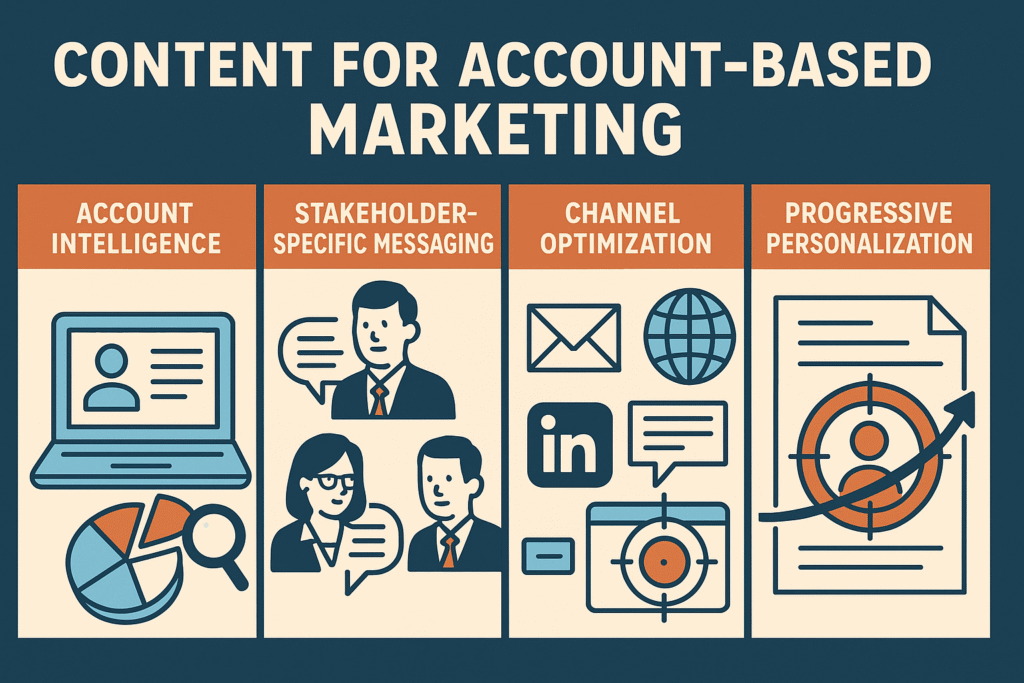Account-Based Marketing has fundamentally changed how B2B companies approach their most valuable prospects. Instead of casting wide nets and hoping for the best, ABM flips the traditional funnel on its head, focusing laser-sharp attention on specific high-value accounts. But here’s what many marketers miss: content isn’t just a supporting player in this strategy—it’s the engine that drives everything forward.
If you’re a content marketer, demand generation manager, or strategist wondering how to make your content work harder in an ABM framework, you’re in the right place. Let’s dive into how content transforms from generic assets into precision instruments that open doors, build relationships, and close deals.

Understanding ABM’s Content Challenge
Traditional content marketing operates on volume and broad appeal. You create assets designed to attract as many qualified leads as possible, casting a wide net across your target market. ABM content strategy requires a completely different mindset.
In ABM, you’re not trying to appeal to thousands of potential customers—you’re speaking directly to maybe 50, 100, or 500 specific accounts. This shift demands content that feels custom-built for each target account, addressing their unique challenges, industry dynamics, and business objectives.
The challenge? Creating this level of personalization at scale without burning through your budget or overwhelming your team. The opportunity? When done right, personalized B2B content can generate response rates that make traditional campaigns look like statistical noise.
The Four Pillars of Effective Content for ABM
1. Account Intelligence as Your Content Foundation
Before you write a single word, you need to understand your target accounts at a granular level. This goes beyond basic firmographics like company size and industry. You need to understand their business priorities, competitive pressures, recent company news, leadership changes, and technology stack.
Your content strategy should be built on account intelligence that includes:
- Recent financial performance and growth initiatives
- Key stakeholders and their professional backgrounds
- Current technology implementations and gaps
- Industry-specific challenges and regulatory pressures
- Competitive positioning and market dynamics
This intelligence becomes the foundation for every piece of content you create. A generic white paper about “digital transformation challenges” becomes a targeted piece about “how mid-market financial services companies are modernizing legacy systems while maintaining regulatory compliance.”
2. Stakeholder-Specific Messaging
B2B buying decisions involve multiple stakeholders, each with different priorities, concerns, and information needs. Your ABM content strategy must account for this complexity by creating content that speaks to each role in the buying committee.
For a typical enterprise software sale, you might need content that addresses:
- C-level executives: ROI projections, competitive advantage, strategic alignment
- IT leaders: Technical specifications, integration requirements, security considerations
- End users: Usability, workflow improvements, training requirements
- Procurement: Pricing models, contract terms, vendor stability
The key is developing content that feels relevant to each stakeholder while maintaining a consistent brand voice and core value proposition. This doesn’t mean creating completely different messages—it means emphasizing different aspects of your solution for different audiences.
3. Channel Optimization for Account Engagement
Where your content lives matters as much as what it says. ABM requires a multi-channel approach that meets your target accounts wherever they consume information. This typically includes:
Direct channels: Personalized emails, direct mail, and account-specific landing pages provide controlled environments where you can deliver highly targeted messages.
Social channels: LinkedIn remains the primary platform for B2B engagement, but don’t overlook industry-specific forums, Twitter discussions, and even emerging platforms where your targets might be active.
Third-party channels: Industry publications, partner content, and speaking opportunities can position your content in front of target accounts through trusted sources.
Sales enablement: Your sales team needs account-specific content they can share during conversations, presentations, and follow-up communications.
The most effective ABM programs coordinate content across all these channels, ensuring consistent messaging while avoiding over-saturation.
4. Progressive Personalization
Not all ABM content needs to be completely custom. Smart marketers use a tiered approach to personalization:
Tier 1 – Industry/Vertical Content: Content tailored to specific industries or market segments. This provides relevance without requiring complete customization for each account.
Tier 2 – Account Cluster Content: Content designed for small groups of similar accounts that share common characteristics, challenges, or business models.
Tier 3 – One-to-One Content: Fully customized content created specifically for individual high-value accounts. This might include custom research, personalized videos, or account-specific case studies.
This approach lets you deliver personalized experiences while managing resource allocation effectively.
Content Types That Drive ABM Success
Research and Insights
Custom research resonates powerfully with target accounts because it provides unique value they can’t get elsewhere. This might include:
- Industry benchmarking studies featuring data relevant to their sector
- Competitive analysis that includes their specific competitors
- Market trend reports that address their geographic regions or customer segments
The key is ensuring your research provides genuinely useful insights, not just thinly veiled product promotion.
Interactive Experiences
Static content has its place, but interactive experiences create deeper engagement and provide valuable data about prospect interests and priorities. Consider:
- ROI calculators customized for specific industries or use cases
- Assessment tools that help prospects evaluate their current state
- Interactive demos that let prospects explore relevant features
- Virtual events designed around topics that matter to your target accounts
Social Proof and Validation
Case studies remain crucial in ABM, but they need to be strategically selected and presented. The most effective approach involves:
- Customer stories from similar companies or industries
- Peer testimonials from recognizable brands in their market
- Third-party validation from analysts and industry experts
- Implementation stories that address similar challenges
Educational Content
Educational content works in ABM when it directly addresses the specific challenges your target accounts face. This includes:
- Technical guides for implementation teams
- Best practice frameworks for decision-makers
- Industry-specific playbooks and methodologies
- Executive briefings on relevant trends and opportunities
Measuring ABM Content Performance
Traditional content metrics like page views and download numbers don’t tell the full story in ABM. You need metrics that connect content engagement to account progression and revenue outcomes.
Account-level engagement: Track how many stakeholders from target accounts are engaging with your content, how frequently they return, and which content types generate the most interest.
Progression metrics: Measure how content consumption correlates with account movement through your sales process. Are accounts that engage with specific content types more likely to progress to qualified opportunities?
Revenue attribution: Connect content engagement to closed deals and revenue. This helps you understand which content investments drive the highest ROI.
Stakeholder mapping: Track which content resonates with different roles within target accounts. This intelligence helps you refine your content strategy and improve targeting.
Implementation Best Practices
Start with Your Sales Team
Your sales team has the most direct relationship with target accounts and the best understanding of their specific needs and challenges. Regular collaboration ensures your content addresses real prospect concerns rather than assumed pain points.
Create feedback loops that capture insights from sales conversations and incorporate them into your content planning. The best ABM content often emerges from questions prospects ask during sales calls.
Invest in the Right Technology Stack
Effective ABM content requires tools that support personalization, automation, and measurement. Your technology stack should include:
- Account intelligence platforms that provide deep insights into target companies
- Content management systems that support dynamic personalization
- Marketing automation tools that can deliver content based on account characteristics
- Analytics platforms that provide account-level performance data
Build Sustainable Processes
ABM content creation can quickly become resource-intensive without proper processes. Develop frameworks that allow for efficient personalization:
- Content templates that can be easily customized for different accounts
- Asset libraries organized by industry, role, and buying stage
- Approval workflows that don’t slow down time-sensitive campaigns
- Content governance that ensures quality while enabling speed
Looking Forward: The Evolution of ABM Content
The future of content for ABM lies in increased automation and AI-powered personalization. We’re already seeing tools that can automatically customize content based on account data, generate personalized videos at scale, and optimize content delivery based on engagement patterns.
However, technology will never replace the need for strategic thinking about what your target accounts truly need to hear. The most successful ABM content programs combine advanced technology with deep customer insights and creative storytelling.
Making It Work for Your Organization
Implementing an effective ABM content strategy requires commitment from leadership, collaboration across teams, and patience to see results. Start small with a pilot program focused on your highest-value target accounts. Test different content approaches, measure results rigorously, and scale what works.
Remember that ABM content isn’t about creating more content—it’s about creating more relevant content. Every piece should serve a specific purpose in moving target accounts through your sales process.
The companies that master this approach don’t just generate better leads—they build stronger relationships, shorten sales cycles, and win more deals. In an increasingly competitive B2B landscape, that advantage might be exactly what you need to hit your growth targets.
Your target accounts are already consuming content to inform their buying decisions. The question is whether that content will be yours, and whether it will be compelling enough to earn their attention and trust. With the right strategy, the answer to both questions can be yes.
